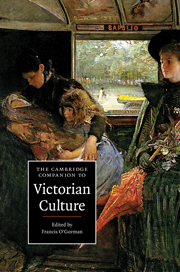12 - Domestic arts
Published online by Cambridge University Press: 28 July 2010
Summary
The idea of the Victorian home
In her 1928 fantasy novel Orlando, Virginia Woolf offered a parodic version of the cultural shift from the eighteenth to the nineteenth century:
The hardy country gentleman, who had sat down gladly to a meal of ale and beef in a room designed, perhaps, by the brothers Adam, with classic dignity, now felt chilly. Rugs appeared; beards were grown; trousers were fastened tight under the instep. The chill which he felt in his legs the country gentleman soon transferred to his house; furniture was muffled; walls and tables were covered; nothing was left bare. Then a change of diet became essential. The muffin was invented and the crumpet. Coffee supplanted the after-dinner port, and, as coffee led to a drawing-room in which to drink it, and a drawing-room to glass cases, and glass cases to artificial flowers, and artificial flowers to mantelpieces, and mantelpieces to pianofortes, and pianofortes to drawing-room ballads, and drawing-room ballads (skipping a stage or two) to innumerable little dogs, mats, and china ornaments, the home - which had become extremely important - was completely altered.
Woolf foregrounds those elements of Victorian domestic culture that her own generation found so repugnant: the clutter and kitsch, the obsession with objects and cosiness. There is also an implied objection to the femininity of this new domestic space - to the muffins and coffee that replace the ale and beef of the eighteenth century.
- Type
- Chapter
- Information
- The Cambridge Companion to Victorian Culture , pp. 219 - 235Publisher: Cambridge University PressPrint publication year: 2010



